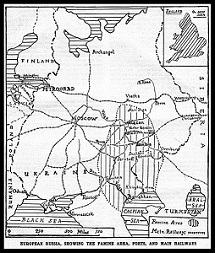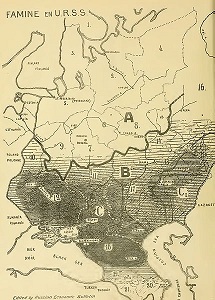The Famine of 1921
Map of the 1921 Famine
- Lasted from 1921 through 1922
- Also known as the Povolzhye famine
- Centered on the Volga-Ural Region
- Drought combined with hampered agricultural seasons and reduced crops aggravated the problem beyond manageability.
- Russia was involved with and host to almost seven years of conflict leading up to the situation, including World War I, the Bolshevik Revolution and the ensuing Civil War.
- Crop seasons were damaged by various armies moving through and using the local food supply as a means of damaging their enemies, but mostly just damaging the farmers they were taking from.
- Seizure of crops led to various levels of distribution to hold their resources and caused a breakdown in the dispersal of needed supplies. What was seized was generally not compensated in any way, which left the bottom part of the food production process bereft of both monetary support as well as bartering options.
- In 1920 leading up to the famine the communist government punished the food producers for withholding compulsory donations during the civil war by having their crops seized and leaving them worse than before.
- Resulted in the death of an estimated 5 million Russians
Further information on the 1921 Famine can be found at Wikipedia: "Russian famine of 1921" and at PBS: "The Great Famine: The story of the American effort to relieve starvation in 1921 Soviet Russia".
The Famine of 1933
Map of the 1933 Famine
- Lasted from 1932-1933
- Centered over a larger area than the 1921-22 famine. Included these regions: Ukraine, Kazakhstan, Northern Caucasus, West Siberia, Kazakhstan, South Urals and the Volga.
- The term holodomor is a term use in reference only to the famine related to the Ukraine, meaning
killing by hunger
. - This famine did not face the same threat of interference from outside sources because the US was embroiled in its own economic collapse and the USSR (United Soviet Socialist Republic, a.k.a. Soviet Union) suppressed all information on the famine until the end of the soviet regime in the 1990's.
- This famine was induced by the increasingly aggressive policy for collectivization in the Soviet Union. Productivity was damaged when the farmers began to fear seizure of their goods and reacted by selling or destroying them before they could be taken, as well as how much labor they were willing to do when they thought that their work would only be confiscated from them.
- It became a fruitless cycle of increasingly rigorous demands and people who became increasingly resistant to cooperation.
- The government had plans to use their collectively produced goods and sell them to a global market, but when the plan showed ultimate signs of failure, instead of revising their plans the government forged ahead, attempting to force their way through obstacles.
- Ultimately the blame fell on the farmers for withholding stores and the government paranoia prevailed instead of adjusting the impossible quotas that had been set upon the farmers. What little was set aside for survival and the following season's planting was seized.
- Data has been evaluated to estimate the casualties from the famine years with number ranging from five to eight million people having died from this manmade disaster.
Further information on the 1933 Famine can be found at Wikipedia: "Soviet famine of 1932 to 1933".
Site Directory
- The Famines of 1921 and 1933

